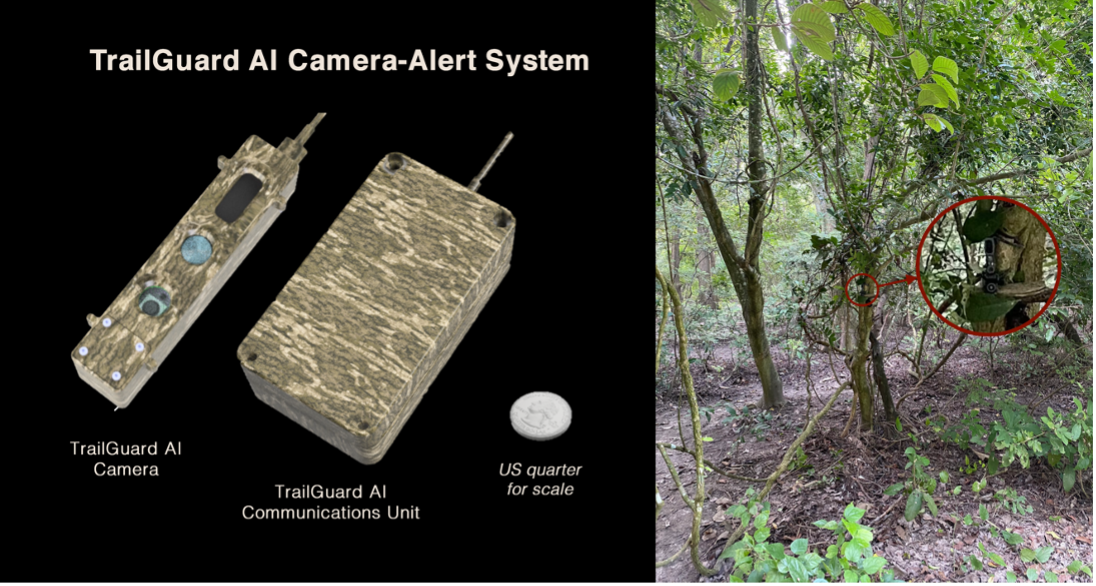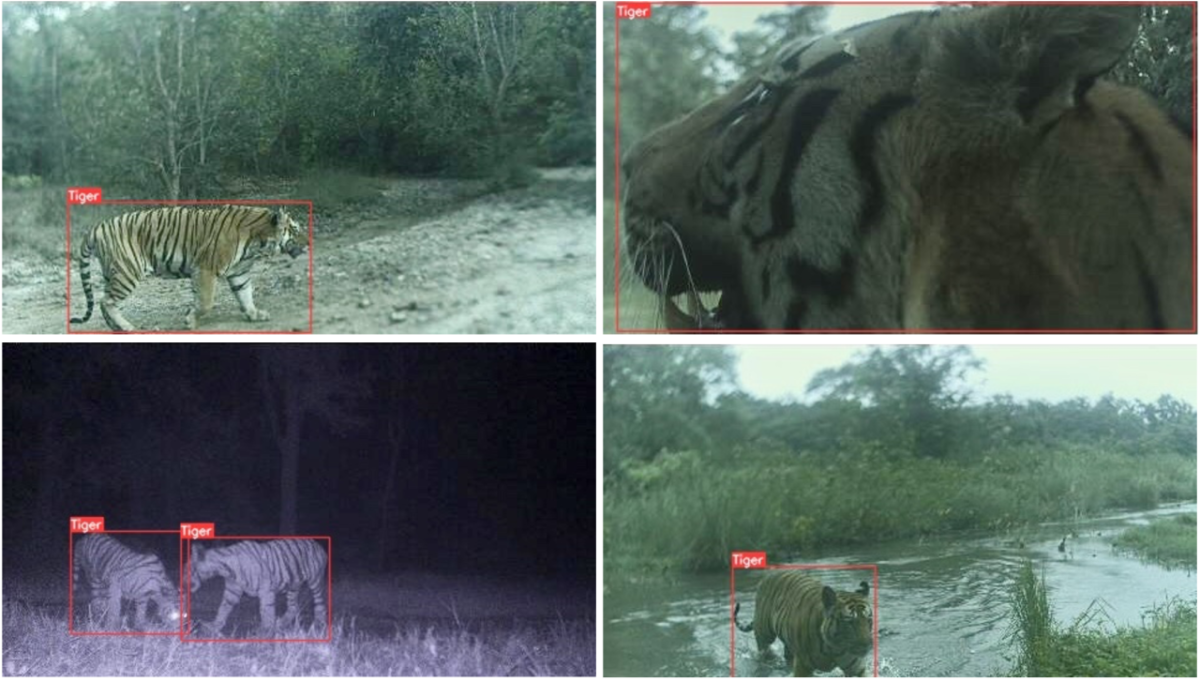Announcing a New Publication Featuring TrailGuard AI: A Novel AI-Based Camera-Alert System Designed To Promote Coexistence Between Tigers and Humans
September 14, 2023 /3BL/ - For decades, tiger biologists have dreamt of a “smart” camera-alerting system capable of detecting a tiger on the prowl and sending images instantly to a cell phone. Whether at dawn, dusk, or midnight, through monsoon rains or stifling heat, the remote unit would function 24/7, with long battery life, to protect and monitor this charismatic species, or detect tigers occupying buffer areas close to villages, and send only images of tigers, elephants, or other conflict prone-species. This wished-for technology could not come at a more important juncture: Over the past 12 years, India has managed to double its wild tiger population, perhaps the greatest conservation success story in the first half of the 21st century. Almost seventy percent of the world’s tigers occur in India, but 26% of that total is found outside protected areas. In fact, many pass their entire lives beyond the boundaries of India’s 53 designated tiger reserves. The potential for conflict with communities that live along the borders or in these corridors and rely on the multi-use buffer areas for livestock grazing is a cause of concern and can result in tigers frequently killing livestock, or in rare occasions attacking humans, leading to retaliation by villagers. From this scenario emerges the major wildlife challenge of our time: how can the recovery of endangered large mammal populations continue, bolstered by the introduction of new technologies, enabling policies, and innovative community–driven programs that promote coexistence of tigers, elephants, and other large mammals in human-dominated landscapes?
Today, the Global Tiger Forum, National Tiger Conservation Authority, the NGO RESOLVE, and Clemson University are excited to announce a major breakthrough in conservation technology: for the first time ever, wild tigers and elephants have been detected by an AI-powered, cryptic camera-alert system, TrailGuard AI, that transmits the images to the cell phones and computers of park managers and other concerned entities in real-time. The elapsed time from the motion sensor triggered by the passing tiger, to loading and performing inference by the AI algorithm on four images, to transmission to the cell network, to the Internet, and to designated authorities is less than 30 seconds, making this technology a true alerting system. To complete the wish list, using cellular communication, the technology can transmit more than 2,500 images on a single battery charge. In short, the dream has come true.
These results are made widely available in a new publication, Mitigating Human-Wildlife Conflict and Monitoring Endangered Tigers Using a Real-time Camera-Based Alert System in the journal BioScience. Since May of 2022 and continuing through the present, TrailGuard AI has been placed in and around five tiger reserves in sections of two of the most productive tiger landscapes in the world: the Kanha-Pench Landscape in Madhya Pradesh, India and the Terai-Arc Landscape in north India and overlapping into lowland Nepal.
This new paper covers the first few months of the field deployment from the monsoon period of 2022. The technology proved its worth almost immediately, detecting tigers moving close to villages and using the same trails as wildlife poachers.
The new technology was prototyped effectively in Africa for the past four years, before being trialed in India. This tiny AI-embedded camera-alert system runs powerful computer models on-board the camera to weed out false positives before transmission of data, thus saving precious battery life, and sending only what the end user requires. Intel and CVEDIA played a critical role in supplying the necessary computer chips and AI software, respectively, to make this innovation possible. First designed to detect poachers, the camera becomes a wildlife detector simply by updating the AI model to detect a range of endangered wildlife species. A new AI algorithm to be used in India, the rest of Asia, and Africa, detects eight output classes: felids; canids; elephants; rhinos; bears; wild pigs; humans; and a catch-all class of other mammals and large birds. Where cell connectivity is excellent, as in much of India, TrailGuard AI takes advantage of the strong signal. Where there is no cell service, this system transmits images over long-range radio (LoRa) or satellite.
The technology cannot come soon enough. While tiger numbers are in ascendance in India, Nepal, and Bhutan, they are declining in much of the rest of the range. Landscape-scale conservation is the most effective way to save area-sensitive, wide-ranging top predators like tigers. The deployment centered on Kanha-Pench, the most important of the 76 Tiger Conservation Landscapes in this predator’s range. The twin anchors of this landscape, Kanha National Park and Pench National Park, and their surrounding habitats, hold more than 500 tigers, the most anywhere. The co-authors of the study are some of the world’s leading experts on tigers and tiger conservation.
"TrailGuard AI has moved from proof-of-concept to becoming part of the tool box to reduce human-wildlife conflict. This technology can be spread to the other tiger-range states as it is so easy to deploy." — Dr. H.S. Negi, former additional chief of wildlife in Madhya Pradesh and Senior Advisor, Global Tiger Forum and senior adviser to Nightjar, the company that produces the system
“AI technology can be a boon for wildlife protection and generating forecasts and alerts in human-wildlife interface areas.” — Dr. S.P. Yadav, Additional Director General (Project Tiger) and Member Secretary, National Tiger Conservation Authority
“Technology can aid park managers and communities in reducing conflict and promoting coexistence. Staffing is limited both inside and outside tiger reserves. TrailGuard AI provides the 24/7 coverage over multiple hotspots of conflict, thus enabling forest management to offset these staffing limitations. We truly have now eyes on the forest and its wildlife and a device that can give us the situational awareness officials desperately need." — Dr. Ramesh Krishnamurthy, landscape ecologist, and professor, Wildlife Institute of India
“Seeing is believing. Besides the real-time transmissions of conflict-prone wildlife species, TrailGuard AI offers park protection that led to the detection and arrest of poachers in Dudhwa.” — Sanjay Kumar Pathak, Former Field Director, Dudhwa Tiger Reserve
Holding workshops involving local communities allowed the team to show how TrailGuard AI could alert villagers gathering firewood or grazing livestock in the multi-use areas to the presence of tigers.
“Integrating communities is essential for co-existence to work and we have gained valuable experience in explaining the technology and listening to how to improve their safety when they use the buffer zone.” — Hrishita Negi, co-author and facilitator of the community-driven workshops that accompanied the tech deployments
Research in Indian tiger reserves also shows that tiger population recovery depends heavily on prey populations, so being able to monitor the status of prey species is vital information to predict recovery.
"Saving tigers requires effective monitoring of the wild population and the prey base. AI-based camera trap technology gives managers that tool, and the said tool detects a wide range of species important to Asian wildlife managers, especially when dealing with human-tiger interface areas. The Global Tiger Forum is committed to foster new technology for furthering the cause.” — Dr. Rajesh Gopal, Secretary General, Global Tiger Forum
Cutting-edge tools can assist tiger range countries in fast and long-term monitoring and protection.
"The technology has also been showcased in range country level events, and several Tiger Range Countries have shown their interest for piloting the same in the near future” — Mohnish Kapoor, Head of Programme and Partnerships, Global Tiger Forum
TrailGuard AI has big ambitions. Now being manufactured in India, it is the first AI-based camera-alert system technology designed by biologists for field biologists and conservationists.
“We follow the guidelines of the government’s directive to ‘Make in India.’ We are trying to make our technology long-lasting and affordable, and simple to install. You only need to remove the lens cap and, as long as end-users are designated as recipients, they start seeing alerts on their cell phones immediately. This can be a game-changer, to be used by Indian conservationists to protect people and wildlife, and around the world wherever wildlife and human populations interact.” – Piyush Yadav, lead engineer and lead of Nightjar, the company producing TrailGuard AI in India
“Our partnership with RESOLVE allows us to bring state-of-the-art AI algorithms, created from synthetic data, to benefit wildlife conservation.” — Mijail Benitez, CVEDIA
“As we take TrailGuard AI to scale, this real-time alerting system for parks and wildlife can become a widespread tool to protect endangered nature. Being part of the evolution of this technology has been gratifying.” — Eric Dinerstein, RESOLVE and Nightjar
The Global Tiger Forum (GTF) is an international, inter-governmental body exclusively set up for the conservation of tigers in the wild in the range countries. The forum is working with range country governments, conservation organizations, and research/academic institutes across the globe for utilizing co-operative policies, evolving common approaches, providing technical expertise, developing scientific modules and other appropriate conservation programs.
Contact: Mr. Mohnish Kapoor, mkapoor@globaltigerforum.org
The National Tiger Conservation Authority (NTCA) is a statutory body under India’s Ministry of Environment, Forests and Climate Change. Its mandate to strengthen tiger conservation in the country by retaining an oversight through advisories/normative guidelines, based on appraisal of tiger status, ongoing conservation initiatives and recommendations of specially constituted Committees. NTCA has been at the forefront of tiger conservation work in India. Its work domain extends from on-the-ground protection initiatives to science-based monitoring of tigers and their habitat using latest technological tools, independent assessment of tiger reserves with MEE framework, financial and technical support to tiger reserves, creating inviolate space for wildlife while ensuring community development to international co-operation are the few thrust areas of NTCA.
Clemson University, a leading public research institution in South Carolina, USA, initiated the Tigers United University Consortium with three other institutions — Auburn University, Louisiana State University and The University of Missouri. Through the consortium, the four universities combine their expertise in academic disciplines important to tiger conservation and protection—wildlife management, engineering, environmental science, conservation social science, veterinary medicine, communications and eco-tourism, to name a few. With more than one university approaching the problem, the odds of success increase.
Contact: Dr. Brett Wright, wright@clemson.edu
RESOLVE is a Washington, DC-based non-profit organization that forges sustainable solutions to critical environmental, social, and health, challenges by creating innovative partnerships where they are least likely and most needed. RESOLVE’s Biodiversity and Climate Program tackles the most pressing conservation problems of our time – the approaching extinction of endangered wildlife and threats to habitats, including tropical forests where most of the world’s species reside – through technological innovation, ambitious global agreements, and targeted land protection.
Contact: Dr. Eric Dinerstein, edinerstein@resolve.ngo
Nightjar is a limited liability social benefit company organized and funded to achieve the social and environmental objectives of developing durable, long-lasting, high technology devices—including the trademarked TrailGuard AI—to facilitate protection and monitoring of endangered species, reducing human-wildlife conflict, and to stop wildlife poaching and illegal logging. Nightjar emerged from the Biodiversity and Wildlife Solutions program at RESOLVE Inc. (RESOLVE), which is a 501(c)3 non-profit organization.
Contact: Dr. Eric Dinerstein, edinerstein@resolve.ngo




